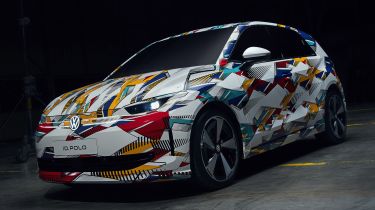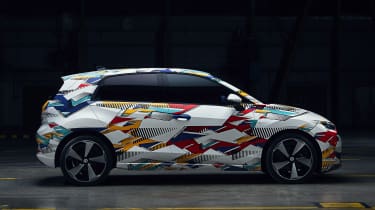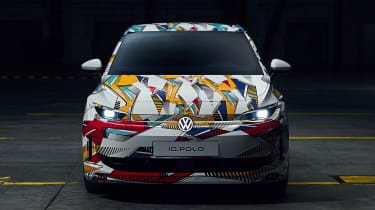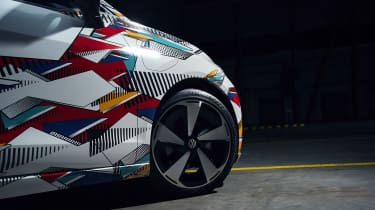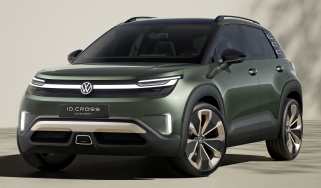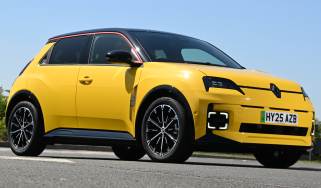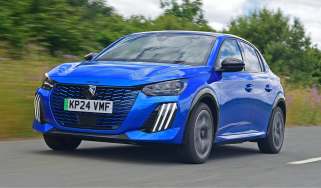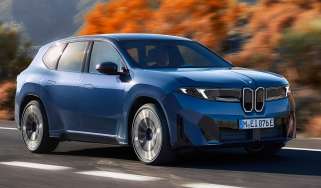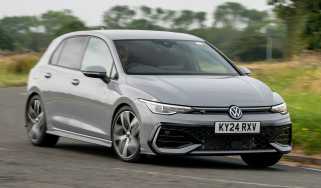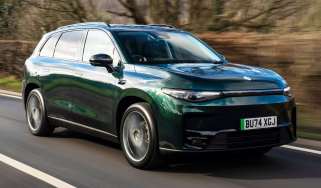Volkswagen ID. Polo opens new era for much-loved supermini
The ID. Polo was originally called ‘ID.2all’ in concept form
It appears Volkswagen has finally made up its mind over its new all-electric supermini, giving it the ID. Polo name ahead of its launch next year.
The ID. Polo moniker was confirmed alongside a suite of new imagery, which shows us new details of the car ahead of its public unveiling at the Munich Motor Show later this month, where it’ll still be under a thin layer of camouflage.
During the ID. Polo’s development, Volkswagen named the concept version ‘ID.2all’ and flirted with the idea of giving it the ID.2 name in production to suit much of its ID-badged EV lineup, such as the ID.3, ID.4 and ID.7.
Back in 2024, Volkswagen CEO Thomas Schäfer said the Polo name is “pretty iconic”, which he followed up by questioning if the name was iconic enough to carry on into the electric era. Well, along with the Golf (which will continue with electric power to become the ID. Golf) and the GTI name (which will spawn performance-focused EVs), we have our answer with the ID. Polo.
Along with the ID.Polo’s name reveal, Schäfer added: “Our model names are firmly anchored in people’s minds. That’s why we’re moving our well-known names into the future. The ID. Polo is just the beginning.” That certainly opens speculation to big-sellers like the Tiguan and long-running models like the Passat gaining pure-electric power and ID-badging in the future.
VW is being open about its fresh push into more affordable EVs. It says that within a year of the ID. Polo going into production, the new model will be joined by a similarly sized all-electric SUV, already previewed by the ID.2all SUV concept that will make a full public debut at the Munich motor show in 2025 under the newly-confirmed ID. Cross name.
Beyond these cars, VW has also confirmed that it is working to deliver an even cheaper EV called the ID.1, which was shown off earlier this year under the ‘ID.Every1’ concept. It’ll sit below the ID. Polo with a proposed price of less than 20,000 Euros (roughly £17,000) when it comes to market in 2027. As for the ID. Polo’s pricing, we expect this will sit around the £22,000 mark - which is around the same as the starting price for the current petrol-powered Polo.
We'll have to wait for the ID. Polo but the Auto Express Buy A Car service has plenty of deals on the current Polo supermini with savings of up to £2,614 on new models and leasing prices from £210 per month
Volkswagen ID. Polo: design
We’ve seen Volkswagen ID. Polo prototypes before, but Volkswagen’s Munich show car has a new camouflage and these official images give us a great look at the car’s design.
Compared with the early test cars, there are a few changes to the front, such as a bonnet that now sits higher, and the end of the front lighting now turns downwards to help simplify manufacturing.
The body itself looks very similar to the ID.2all concepts and the rear door handles remain hidden like the concept - though spied prototypes have used normal rear door handles. The rear end also looks to be close to production, with a light bar, square-shaped lighting graphics and a clean, simple tailgate.
But the big news is under the skin, because the ID. Polo also heralds a heavily reformed electric architecture. As well as improving efficiency, it will also lower the price of building the cars for VW, something the German giant is relying on to re-establish its position as Europe’s biggest and most profitable mainstream manufacturer.
There’s a lot at stake for VW, but the future ID. Polo is promising big things, not least the introduction of a 25,000-Euro starting price (around £22,000) when it arrives in the UK. It’ll achieve this through a variety of means, including a simplified platform called MEB Entry, but should also prove profitable – a crucial aspect for the survival of VW in the electrified age.
The new platform’s development is being done in collaboration between Volkswagen and its sister brand Cupra, whose Spanish plants will build all MEB Entry models, including future Skoda and Volkswagen SUVs and the new Cupra Raval, which will be the first to reach production in mid-2025.
Beyond offering a low-cost supermini, the ID. Polo will also be the first all-electric car to offer an ID. Polo GTI edition, which has already been previewed by the ID. GTI concept. The ID. Polo GTI has been confirmed for launch in 2026 alongside the standard car, providing Volkswagen with a fresh rival to all-electric hot hatches like the MINI JCW Electric and Alpine A290. Volkswagen has also confirmed it’ll bring a camouflaged version of the ID. Polo GTI to the Munich show in September.
But the future VW ID. Polo will have a tough crowd to compete with, including a range of new rivals such as the Renault 5, Fiat Grande Panda and Citroen e-C3. There’s also a brand-new set of Stellantis rivals on their way in the coming years. These include a new Peugeot E-208 and Vauxhall Corsa Electric, which will sit on their own refreshed platform.
Volkswagen ID.2all concept: platform and powertrain
The MEB Entry project is an offshoot from the MEB platform that delivered the likes of the VW ID.3 and Skoda Enyaq – but it’s designed from the outset to support smaller, cheaper vehicles. As such, it switches layout from rear to front-wheel drive and makes use of a less complex torsion-beam rear suspension to boost practicality and keep a lid on costs.
The new concept is said to have been created in less than two months, under the guidance of VW’s design boss, Andreas Mindt, who only joined the brand earlier this year. The former Audi and Bentley man has created a much cleaner, simpler-looking vehicle than the futuristic, more visionary ID.Life, which was canned by VW’s brand boss Thomas Schäfer within days of him starting in the position.
Even though the ID. Polo won’t go on sale for another year, VW has taken the unusual step of confirming several of its key technical details. The concept’s single front-mounted motor produces 223bhp – enough, the firm says, for a 0-62mph time of around seven seconds.
The battery pack will come in two sizes: 38 and 56kWh, but the chemistry involved is as yet unknown. VW says that it expects a WLTP range figure of around 280 miles for the larger pack, and that DC charging will take the battery pack from 10 to 80 per cent of its capacity in around 20 minutes, thanks to a 125kW peak charging capacity. Given that there are two battery options, these figures will almost certainly relate to models fitted with the larger pack.
Volkswagen ID. Polo: interior and technology
The great news is that we already have a very clear idea of what to expect with the new ID.Polo thanks to the ID.2all concept that was revealed in 2023. As well as revealing the all-new exterior design language overseen by new design chief Andreas Mindt, it also gives a clear indication of the brand’s future interior and interface design. These two elements have been at the top of the list for VW to reinvent after less than favourable reaction to the first ID models.
First and foremost, the production car will likely retain the concept’s pair of screens on the dash – a 10.9-inch screen for the driver and a 12.9-inch infotainment screen. On the concept, you can choose between eras of Volkswagen cars as themes for the displays; a Vintage setting is designed to mimic the dash of an old Golf, Classic mode apes the readouts of the original Beetle, and a Modern mode reflects the latest thinking for the ID. Polo.
But the bigger change is the move away from controls within touch panels or screens, and a return to physical controls for key elements like volume and cabin temperature. On the ID.2all concept these are mounted below the central display.
The steering wheel also does away with touch sliders; they’re replaced by rotating thumbwheels and just four regular buttons. And in another small but significant move away from the ID.3’s interface, there are four electric-window controls for the driver – instead of just a pair and a front/rear selector.
The gear selector has been moved to a stalk mounted on the steering column – a move already seen on VW’s latest MEB models – while between the front seats, there’s a dial controller that’s said to be for switching between the drive modes.
The concept’s boot capacity is 440 litres – nearly 60 litres up on the ID.3, and more than 100 litres larger than many Polos – rising to 1,330 litres when the rear seats are folded down. The boot floor has an adjustable height and there’s also a novel 50-litre storage area beneath the second row; VW says that while this lockable compartment has been conceived to house the charging cables, it could also be ideal for items like laptops, allowing them to be charged while they are stored.
Volkswagen ID.2all concept: design
The front end and profile could easily pass for those of VW’s conventionally powered supermini, although there’s a single strong crease running along the flanks, and the rear door handles are hidden beyond the side windows. There’s also a fresh interpretation of the signature C-pillar from the Golf, too; this alone is a strong hint that the concept may not carry the ID. badge in production form. In contrast to many recent offerings, the ID.2all doesn’t make overt statements that it lacks a combustion engine.
Mindt described the concept as “an homage to the Beetle, Golf and Polo” that encompasses what VW calls its key values, stability and likeability. And sure enough, the concept car from 2023 looks pretty detached from any of the ID. models that we’ve already seen – certainly much more conventional than the ID.3 hatchback. It’s 4,050mm long and has a wheelbase of 2,600mm – so a couple of centimetres shorter than the current Polo overall, but with five centimetres more between the front and rear axles.
Did you know you can sell your car through Auto Express? We’ll help you get a great price and find a great deal on a new car, too.
Find a car with the experts

